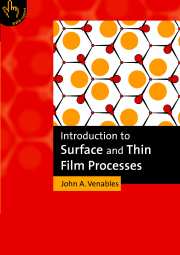Book contents
- Frontmatter
- Contents
- Preface
- Chapter 1 Introduction to surface processes
- Chapter 2 Surfaces in vacuum: ultra-high vacuum techniques and processes
- Chapter 3 Electron-based techniques for examining surface and thin film processes
- Chapter 4 Surface processes in adsorption
- Chapter 5 Surface processes in epitaxial growth
- Chapter 6 Electronic structure and emission processes at metallic surfaces
- Chapter 7 Semiconductor surfaces and interfaces
- Chapter 8 Surface processes in thin film devices
- Chapter 9 Postscript – where do we go from here?
- Appendix A Bibliography
- Appendix B List of acronyms
- Appendix C Units and conversion factors
- Appendix D Resources on the web or CD-ROM
- Appendix E Useful thermodynamic relationships
- Appendix F Conductances and pumping speeds, C and S
- Appendix G Materials for use in ultra-high vacuum
- Appendix H UHV component cleaning procedures
- Appendix J An outline of local density methods
- Appendix K An outline of tight binding models
- References
- Index
Appendix J - An outline of local density methods
Published online by Cambridge University Press: 06 July 2010
- Frontmatter
- Contents
- Preface
- Chapter 1 Introduction to surface processes
- Chapter 2 Surfaces in vacuum: ultra-high vacuum techniques and processes
- Chapter 3 Electron-based techniques for examining surface and thin film processes
- Chapter 4 Surface processes in adsorption
- Chapter 5 Surface processes in epitaxial growth
- Chapter 6 Electronic structure and emission processes at metallic surfaces
- Chapter 7 Semiconductor surfaces and interfaces
- Chapter 8 Surface processes in thin film devices
- Chapter 9 Postscript – where do we go from here?
- Appendix A Bibliography
- Appendix B List of acronyms
- Appendix C Units and conversion factors
- Appendix D Resources on the web or CD-ROM
- Appendix E Useful thermodynamic relationships
- Appendix F Conductances and pumping speeds, C and S
- Appendix G Materials for use in ultra-high vacuum
- Appendix H UHV component cleaning procedures
- Appendix J An outline of local density methods
- Appendix K An outline of tight binding models
- References
- Index
Summary
Although we introduced density functional theory (DFT) in section 6.1 in the context of Lang and Kohn's work on metal surfaces, the concept itself is much broader. It consists of setting up a general single particle method to solve the Schrödinger equation for the ground state of a many electron system by: (1) showing that the equation can be solved variationally to give an upper bound to the energy of the system expressed in terms of the electron density n(r), sometimes written ρ(r); this theorem was introduced by Hohenberg & Kohn (1964); and (2) proposing practical schemes whereby this theorem can be implemented as an iterative computational method, starting from a set of approximate wave functions describing the ground state of the electron system. The main non-relativistic scheme in use is due to Kohn & Sham (1965). The pervasiveness of these methods was recognized in 1998 by the award of the Nobel prize for chemistry to Walter Kohn (Levi 1998).
Writing down too many equations specifically here will take too much space, and may encourage the reader to believe that the method is simpler than it actually is. Some of the key review articles have been cited in sections 6.1.2 and 7.1.3. So many words have already be spilt on the topic, the methods are so widespread, and yet no-one can give a measure of just how good an approximation DFT represents, or say categorically whether further developments such as GGA necessarily improve matters, that there is no sense in which I should try to confuse you further.
- Type
- Chapter
- Information
- Introduction to Surface and Thin Film Processes , pp. 326 - 327Publisher: Cambridge University PressPrint publication year: 2000



